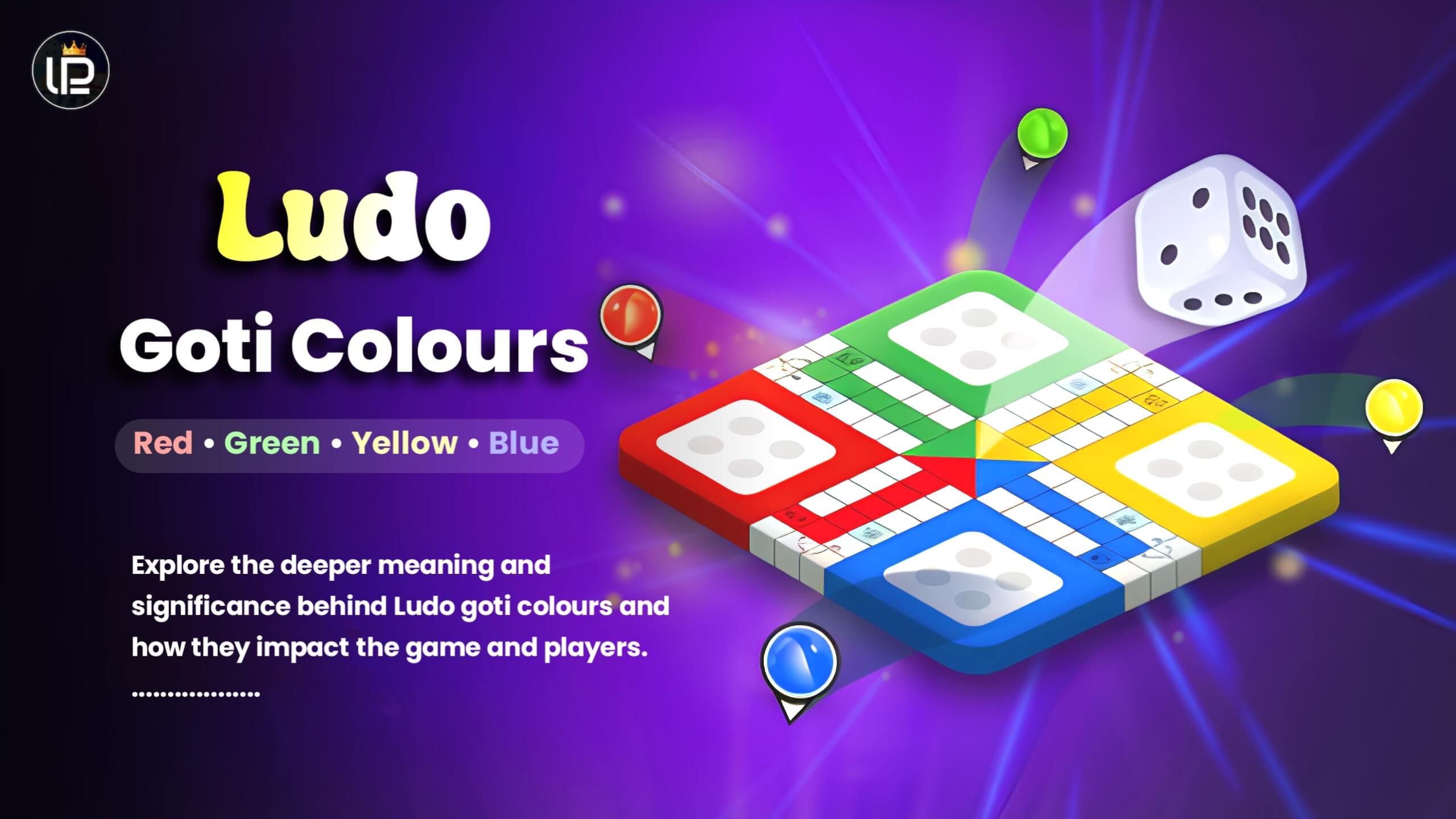Ludo is a classic board game that has brought fun to families, friends, and communities for many years.
People play it on quiet Sunday afternoons, during fun get-togethers, or even on mobile apps today. No matter the time or place, Ludo remains a favorite game for people all over the world.
One of the first things you notice when you open a Ludo board is how bright and colorful it looks, especially the small playing pieces, called gotis. But have you ever thought about why these gotis come in different colors? Are the colors just for decoration, or do they have a special meaning?
In this blog post, we’ll take a closer look at the colors of Ludo gotis. We’ll learn about where the colors came from, how they make us feel, what they mean in different cultures, how they affect the way we play, and how their meaning has changed from the old board game to the digital version.
By the end, you might see your Ludo pieces in a whole new way!
A Brief Overview of Ludo
Before discussing the colors, let’s quickly review what Ludo is for anyone who doesn’t know the game.
Ludo started in India and is based on an old game called Pachisi, which people played as far back as the 6th century. The version of Ludo we know today was created in England in 1896 and is now played all around the world.
The game uses a square board with four colored areas: red, blue, green, and yellow. Each player has four small pieces (called gotis) that match their color. The aim is to move all four pieces from the starting area to the center of the board by rolling a dice.
Ludo is easy to learn and fun for everyone because it mixes strategy with luck.
The Four Ludo Goti Colours
1. Red
2. Green
3. Yellow
4. Blue
These colors have been standardized across almost all physical and digital versions of Ludo. Let’s now explore the meaning and importance of each color.
The Psychology of Colour in Ludo
Color psychology is about how different colors can affect the way we think, feel, and act. People in different cultures may see colors in different ways, but some colors make most people feel similar things.
In a game like Ludo, the colors of the pieces might quietly change how we see the game, how we see other players, and how confident we feel about winning.
Let’s look at each color one by one.
Red: A Color of Power and Action
In many cultures, red stands for strength, urgency, and energy. On a Ludo board, the red gotis (pieces) often look the brightest and most noticeable. It’s the color that catches your eye first.
How It Affects the Game:
-
Confidence Boost: Players might feel more powerful or like a leader when playing with red gotis.
-
Aggressive Play: Red can make players feel more competitive and push them to attack others more often.
-
Easily Seen: Red stands out, so opponents may notice and target your pieces more quickly.
Cultural Meaning:
In India, Red is seen as a color of celebration, weddings, and strength. It’s full of energy and is often chosen by the first player to start the game.
Green: The Color of Calm and Smart Thinking
Green is a color that makes people think of peace, balance, and growth. In the game of Ludo, the green area is usually across from the red one, which might show a balance between bold moves and waiting patiently.
What It Means in the Game:
-
Smart Planning: Green players often like to think ahead and make careful moves.
-
Patience: Green has a calming feel, which might help players wait for the right time to act.
-
Steady Progress: Green stands for slow but sure steps, which can be a great way to win in the long run.
Cultural Meaning:
In many Eastern cultures, green stands for life, success, and peace. It reminds people of nature and new beginnings.
Yellow: The Color of Joy and Good Luck
Yellow is a bright and happy color. It makes people think of sunshine, hope, and fun. It’s one of the most playful and noticeable colors in a game.
What It Means in the Game:
-
Playful Mood: Players with yellow pieces might play in a fun and relaxed way.
-
Bold Moves: Yellow is linked to fun and being spontaneous, so players might take more risks.
-
Lucky Feelings: Yellow feels warm and positive, and many people think it brings good luck.
Cultural Meanings:
In many Asian countries, yellow stands for royalty and wisdom. In India, yellow is the color of turmeric, which is used in many important and lucky traditions.
Blue: The Color of Intelligence and Trust
Blue is a calm and smart color. It makes people feel safe and clear-minded. That’s why many smart and experienced players like it.
What It Means in the Game:
-
Smart Thinking: People who like blue often think carefully and plan ahead.
-
Stays Calm: Blue helps players stay cool and focused, even in stressful times.
-
Not Too Aggressive: Blue doesn’t feel aggressive, so blue players might seem less dangerous, which can be a good thing.
Cultural Meanings:
In Indian stories, blue is linked to gods like Lord Krishna, showing truth and greatness. Around the world, blue is seen as a color you can trust.
Choosing Colors in Ludo
In Ludo, the color a player picks often becomes part of their identity. Some people have a “lucky color” and always choose it. Over time, they may feel that a specific color helps them win or lose, which makes the game more personal and fun.
For example:
-
“I always win when I play blue.”
-
“Red feels too aggressive for me.”
-
“Green is my lucky charm!”
These color choices can also affect how people play together. Friends or family members might race to pick their favorite colors first, leading to friendly competition and little traditions every time they play.
Do Colors Affect Winning in Ludo?
Many Ludo fans often wonder if the color you play with can affect your chances of winning, especially in online games where results are tracked.
There’s no official study on this, but some online data and player experiences suggest:
-
Red and Blue win more often, maybe because they go first in many digital versions.
-
Yellow and Green sometimes win less, though it depends on the app or game version.
Still, most experienced players believe that your strategy, timing, and a bit of luck matter much more than the color you choose. That said, just believing a color is better or worse can change how people play.
Ludo in the Digital Age: Colours in Apps
Ludo is now very popular as a mobile game. Apps like Ludo Players and Ludo King have millions of players around the world. The piece colors are still the same as the classic board game — red, green, yellow, and blue.
But online games bring some new features:
-
Avatars and Skins: Some apps let you change how your pieces or character look, so you can feel more connected to your favorite color.
-
Choosing Your Colour First: You can pick your favorite color before the game starts, which helps show your personal style.
-
Game Stats: Many apps keep track of how often you win or lose with each color. This helps you see patterns and maybe choose better next time.
Even though the game is digital, people still feel strongly about their favorite Ludo color, just like when playing on a real board.
Symbolism Across Cultures
Colors in Ludo seem the same everywhere, but people in different places and cultures understand them a little differently. Here are some examples:
| Colour | Indian Symbolism | Western Interpretation | Chinese Culture |
|---|---|---|---|
| Red | Auspicious, power | Danger, excitement | Happiness, luck |
| Green | Nature, harmony | Freshness, stability | Health, growth |
| Yellow | Purity, learning | Joy, caution | Royalty |
| Blue | Divinity, depth | Calm, logic | Immortality |
Knowing these meanings makes the game more interesting, especially when people from different cultures play together.
Strategic Advice: Choosing the Right Colour for You
Choosing a colour won’t make you win for sure, but it can affect how you play and feel.
-
Pick Red if you like being bold, taking charge, and making risky moves.
-
Choose Green if you’re patient, like to think carefully, and plan your moves.
-
Go with Yellow if you enjoy being fun, creative, and spontaneous.
-
Choose Blue if you like staying calm, planning well, and being steady.
Or, if you want to try something new, pick a colour you haven’t used before—you might find a new way to play!
Conclusion:
To most people, the colors of the Ludo gotis just help tell the players apart. But as we’ve talked about in this blog, these colors mean much more. They connect to our thoughts, culture, strategies, and even our personal style.
So next time you play Ludo, take a second to notice your goti’s color. It’s not just a token — it can show how you play, how you think, and maybe even a bit about who you are.
Enjoy the game — and may your color lead you to victory!


Leave a Reply